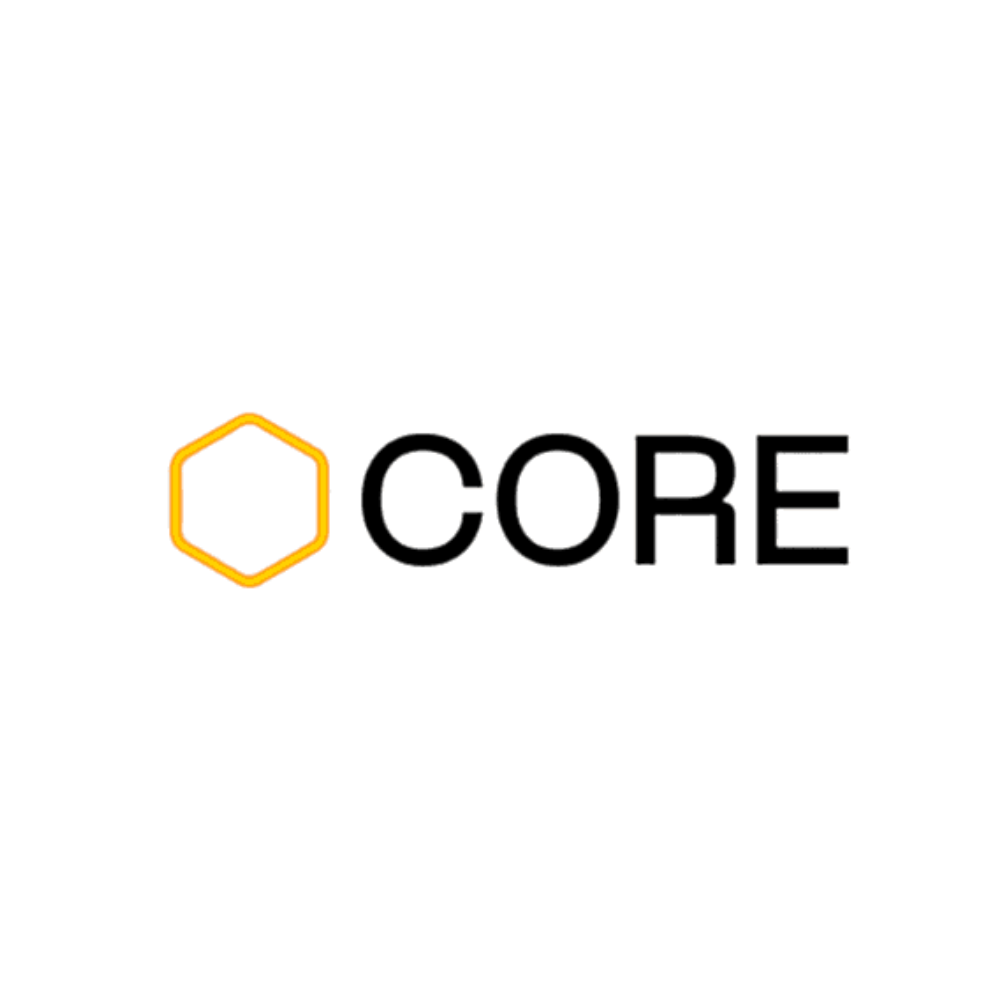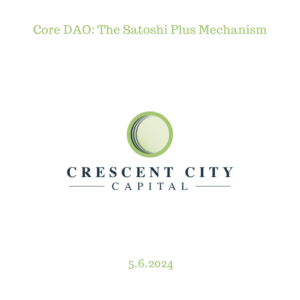Core DAO: The Satoshi Plus Mechanism
By Andy Wang | Crescent City Capital Market Analyst Intern
What is Core DAO?
CORE is a web3 blockchain that aims to be inclusive, decentralized, secure and more efficient. This is done by combining proof of work (PoW) and delegated proof of stake (DPoS) mechanisms to achieve the Satoshi Plus consensus.

CORE is an innovative network seeking to provide a solution for the much-discussed blockchain trilemma. With its Satoshi Plus consensus, CORE is able to simultaneously use different mechanisms from multiple blockchains. Through this unique combination of features, CORE can achieve decentralization with Bitcoin’s PoW model, scalability through DPoS and optimal security thanks to its robust consensus mechanism.
The CORE network is a community-driven effort with no single founder or developer holding the reins. Instead, an entire team has come together to form a DAO known as the CORE DAO. Soon, users will be able to join the growing user base in helping shape CORE’s future.
How Does CORE Works
Core uses the Proof of Work consensus algorithm and a modified Proof of Stake algorithm called Delegated Proof of Stake. The Core blockchain is powered by its newly conceived mechanism called satoshi plus.
- Proof of Work
The Core blockchain borrows a leaf from the proof of work consensus mechanism implemented by Bitcoin and Dogecoin. PoW is a practical decentralized mechanism enabling participation in mining for anyone with computing power. Core relayers transmit each Bitcoin block as a transaction to the Core chain. This relaying mechanism allows Satoshi Plus to validate delegated hash power in a trustless manner while also benefiting from the strong security model of the Bitcoin network to secure Core.
- Delegated Proof of Stake
The proof-of-stake consensus mechanism involves staking cryptocurrencies to secure the network. Ethereum is the largest blockchain network that currently utilizes this validation model. Notably, delegated proof-of-stake (DPoS) is an improved version of the proof-of-stake mechanism. The DPoS mechanism was created to allow smaller stakers to vote or elect validators. The Core protocol combines the DPoS validation model with the proof-of-work model.
- Satoshi Plus Consensus Mechanism
The working principle of this satoshi plus mechanism adopted by the Core network is that it leverages Bitcoin’s proof of work consensus and the Delegated proof of stake mechanism while also ensuring EVM compatibility.
The satoshi plus consensus mechanism is unique in incorporating hash power generated by Bitcoin miners and delegated proof of stake. This improves decentralization and security while enhancing scalability, making it better than the proof of work mechanism. The satoshi plus mechanism bridges the gap for developers who want to create apps that integrate well with web3 and foster real decentralization.
This system is unique, so let’s examine its parts in more detail to understand its operation. First, here are the ecosystem participants.
- Validators: The role of validators in the chain is to confirm transactions and simultaneously create new blocks.
- Delegators: Users who cannot afford to be validators can still participate in the chain by selecting validators and then staking some of their Core tokens with them. This category of users is the delegators. They also pay the validator a particular percentage of commission since the validator helps them interact with the chain directly.
- BTC miners: In the description of how the satoshi mechanism works, it was mentioned that hash powers are obtained from bitcoin miners, which are transferred to validators.
- Verifiers: The verifiers report bad players on the network. A validator that engages in malicious activity may be punished by having their reward or stake reduced or even imprisoned; in this case, they are ejected from the validator’s list.
Core’s Satoshi Plus mechanism seeks to improve decentralized models in the crypto ecosystem. This will enable businesses to further participate in web3 and be fully persuaded of the impact of blockchain. Ultimately, the goal of Core is to create a safe, decentralized, and scalable network all at once by combining the benefits of the Bitcoin proof-of-work consensus model with a delegated proof-of-stake consensus.
What Is CORE Used For?
As the system’s main token, CORE is used as a reward for node operators who either provide hashing power or stake their CORE tokens to become validators on the CORE network. CORE token holders can delegate their tokens to a validator and vote to validate transactions. The CORE token is also used to compensate relayers who help to secure the blockchain network.
As CORE DAO becomes sufficiently decentralized, users will be able to stake their tokens to vote and make decisions for the improvement of the network.
Core DAO (CORE) Tokenomics
CORE has a hard cap with an upper limit of 2.1 billion tokens. It has a circulating supply of 59.3 million and a current market cap of $178.1 million. The tokens were initially allocated as follows:
- 39.99% of the total token allocation goes to the node miners. Core has to pay miners and stakers safeguarding the network for their efforts to get the project off the ground. To guarantee long-term incentive alignment, node payments will be dispersed over a lengthy period, about 81 years. Transaction fees are another sort of compensation that nodes may get.
- 25.029% of the total token allocation goes to the users. Users of Core should be aware that this chain was created with them in mind from the outset. The millions of users in a decentralized base will receive airdropped CORE tokens.
- 15% of the total token allocation to contributors on the chain. The payment will reward past, current, and potential Core contributors.
- 10% of the total token allocation goes to the reserves. The foundation may eventually utilize this reserve to raise money without having to centralize the token supply.
- 9.5% of the token allocation goes to the treasury. The DAO will receive the required funding from the treasury to complete the ecosystem.
- 0.476% of the token allocation goes to the relayers. Relayers must be paid for their contributions to the chain’s security, much like nodes, to function. Transaction fees serve as compensation for relayers as well.
Due to their function on the Core network, CORE coins require a decentralized distribution. The Core Network’s utility and governance token, CORE, has the following capabilities, among others:
- Transaction fees
- Staking
- Governance of the core network
With these crucial roles, CORE token holders have a big job running and maintaining the Core network. Decentralization, self-sovereignty, and stability are all supported by specific unbreakable concepts that are part of Core’s tokenomics.
CORE Market Recap and Price History
The CORE price today is $1.95 USD with a 24-hour trading volume of $55,598,362 USD, it had its 24H high of $2.06 recorded on May 5, 2024. CORE is down 3.10% in the last 24 hours. The current CoinMarketCap ranking is #57, with a live market cap of $1,730,213,196 USD. It has a circulating supply of 885,936,228 CORE coins and a max. supply of 2,100,000,000 CORE coins.
Let’s now take a look at some of the highlights and lowlights of the CORE price history. While past performance should never be taken as an indicator of future results, knowing what the coin has done can help give us some very useful context when it comes to either making or interpreting the CORE price prediction.
When CORE first came onto the open market in February, 2023, it was worth $4.2575. It then dropped to under $0.50 since then, only jumping on April 2, 2024, at $3.20. The coin decreased again on April 14, reaching $1.3585, before rebounding to $2.07 on April 18, 2024.
At that time, there were 881.4 million CORE in circulation, out of a total supply of 2.10 billion. This gave CORE a market cap of about $2.76 billion, making it the 45th largest crypto by that measurement.
CORE Price Analysis
At its market launch, the price of CORE reached an all-time high of $6.9 Core/USDT on February 9, 2023. Since then, it has fallen, finding a bottom at $0.29 on November 3, 2023. After moving sideways, with a resistance of $1.20 it made a breakout in late March 2024
CORE spiked to $4.37 on April 2, increasing by over 725% since its March 20 low of $0.53. The recent surge in the price of CORE, as highlighted by Coretoshis Lab, can be attributed to a confluence of factors that have ignited investor interest and speculation in the cryptocurrency. Coretoshis Lab serves as a catalyst for this surge, shedding light on potential developments that could drive CORE’s price to unprecedented heights.
The tweet stated that the news is considered very trustworthy, with more than 100 crypto institutional investment funds planning to purchase and hold CORE in the current year. The CoretoshisLab account also shared optimism about the token’s future, saying, “In the upcoming month, we will definitely reach the Moon.” In 2024 CoreDAO will experience tremendous growth that is beyond imagination.
Coretoshis asserts the high credibility of this news, indicating the involvement of over 100 crypto institutional investment funds poised to buy and hold CORE this year. The endorsement of institutional interest adds legitimacy to the narrative, instilling confidence in investors and attracting further attention to the project.
Corretoshis exudes optimism about CORE’s future trajectory, urging followers not to miss the opportunity for potential gains. References to “going to the Moon” and the promising prospects of CoreDAO in 2024 amplify the hype surrounding CORE, fueling FOMO (Fear of Missing Out) among investors keen on capitalizing on its upward momentum.
However, it then came crashing down by 73% to a low of $1.17 on April 12. A bounce from the previous resistance happened, with the price spiking to nearly $2.9.
Looking at the chart, it looks like after CORE is in a price-discovery phase, and I expect this bullish price action to continue, although there could be a short-term downturn. The day chart Relative Strength Index came to the natural zone at 46, indicating that a reversal might take place.
With the price now being traded around $2, we will see if there is a potential for an upturn or if it will continue to slump further to its recent low at $1.17.
If it does break out, CORE could, potentially, reach a new all-time high, and try to fight through its historical high at $6.
Conclusion
Another thing worth mentioning is that On April 1, 2024, the Core Chain teamed up with Multibit/Bitstable: Core Journey Campaign was launched, further fueling excitement surrounding the CORE coin. This campaign aims to promote the Core ecosystem and its associated tokens, generating additional buzz and enthusiasm among investors. Beyond that, CORE said it’s introducing non-custodial BTC staking: “Making BTC a yield-earning asset without leaving the Bitcoin network, for the first time in history.”
As CORE continues to captivate the cryptocurrency community with its meteoric rise, investors remain eager to capitalize on its potential for further growth and development in the evolving landscape of decentralized finance (DeFi). With the market sentiment still in the greed mode and BTC halving event completed not long ago, this BTC-related token will have tremendous upside potential.
Reference
https://coinmarketcap.com/currencies/core-dao
https://twitter.com/Coredao_Org?ref_src=twsrc%5Egoogle%7Ctwcamp%5Eserp%7Ctwgr%5Eauthor
https://docs.coredao.org/core-white-paper-v1.0.7/introduction
https://alternative.me/crypto/fear-and-greed-index

